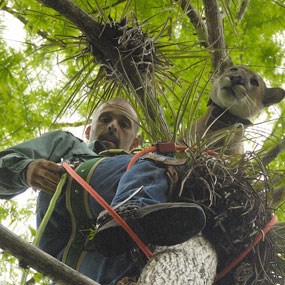
Ralph Arwood Big Cypress Panther Capture Work In 2007, the NPS had an intensive and successful February capturing panthers. In 22 days of hunting, they treed 12 panthers. Four of these panthers (3 females and 1 male) had never been collared. It was found that two of the four had been handled before, thanks to the microchip placed under their skin when they were kittens in a den. Florida panther #150, that started out as kitten #152, was born in July of 2003. Florida panther #151 was marked as kitten #113 in her den in April of 2002. Information such as this helps determine how successfully panthers survive to adulthood. The team also changed the radio-collar on 4 panthers, and, in 4 situations, decided to leave the panther without handling it because it was too high in the tree for a safe capture. During February of 2007, the team also marked 2 male kittens in the den of Florida panther #124. They are the 224th and 225th kittens handled at dens since April of 1992. 
Ralph Arwood Who has the toughest job on a capture team? 
Ralph Arwood 
Ralph Arwood The wrong place at the wrong time… |
Last updated: April 14, 2015
